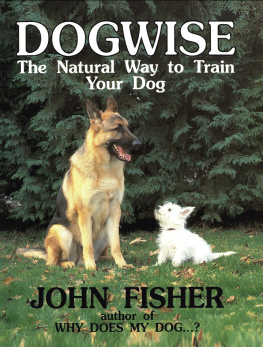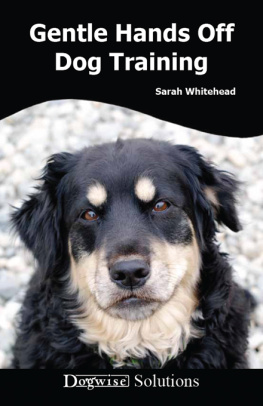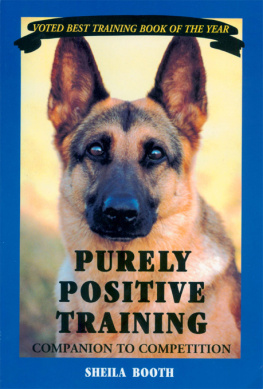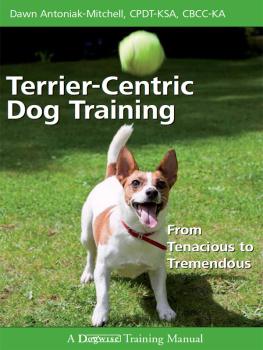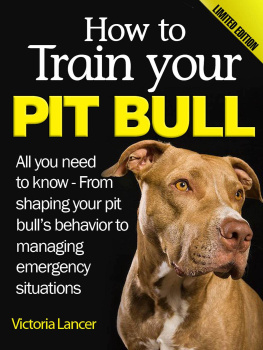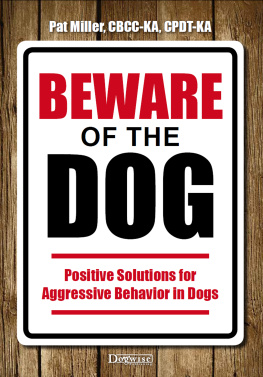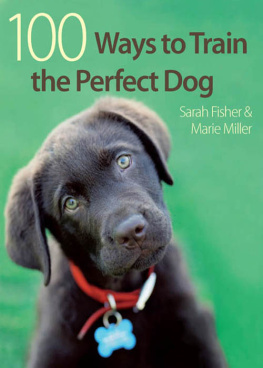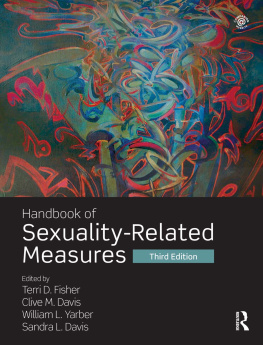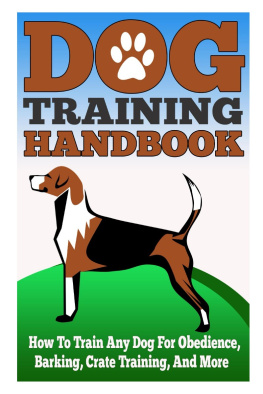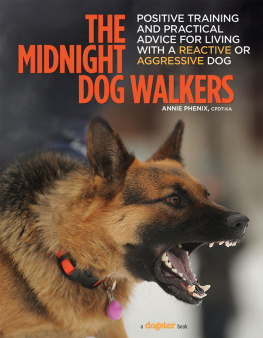John Fisher - Dogwise: The Natural Way to Train Your Dog
Here you can read online John Fisher - Dogwise: The Natural Way to Train Your Dog full text of the book (entire story) in english for free. Download pdf and epub, get meaning, cover and reviews about this ebook. year: 1996, publisher: Souvenir Press, genre: Detective and thriller. Description of the work, (preface) as well as reviews are available. Best literature library LitArk.com created for fans of good reading and offers a wide selection of genres:
Romance novel
Science fiction
Adventure
Detective
Science
History
Home and family
Prose
Art
Politics
Computer
Non-fiction
Religion
Business
Children
Humor
Choose a favorite category and find really read worthwhile books. Enjoy immersion in the world of imagination, feel the emotions of the characters or learn something new for yourself, make an fascinating discovery.
- Book:Dogwise: The Natural Way to Train Your Dog
- Author:
- Publisher:Souvenir Press
- Genre:
- Year:1996
- Rating:5 / 5
- Favourites:Add to favourites
- Your mark:
- 100
- 1
- 2
- 3
- 4
- 5
Dogwise: The Natural Way to Train Your Dog: summary, description and annotation
We offer to read an annotation, description, summary or preface (depends on what the author of the book "Dogwise: The Natural Way to Train Your Dog" wrote himself). If you haven't found the necessary information about the book — write in the comments, we will try to find it.
Dogwise: The Natural Way to Train Your Dog — read online for free the complete book (whole text) full work
Below is the text of the book, divided by pages. System saving the place of the last page read, allows you to conveniently read the book "Dogwise: The Natural Way to Train Your Dog" online for free, without having to search again every time where you left off. Put a bookmark, and you can go to the page where you finished reading at any time.
Font size:
Interval:
Bookmark:
ACKNOWLEDGEMENTS
I would like to thank the following people who helped to make this book possible:
The Wood Green Animal Shelters and their staff at Godmanchester for allowing us to have Major in the first place, together with the photographs of their magnificent facilities.
Tony Glue for his wonderful ability to photograph dogs; it takes a GSD man to capture both the mood and the movement.
My friend Jill Holness whose ability to whizz around a word processor saved me hours of work; my only comment about her typewriting skills is that she needs all ten fingers, whilst I can type with just two.
My thanks also to go Hilda Mummery who allowed Daisy, her cute Westie puppy, to appear on the front of the jacket with Major.
Naturally, I thank Major for being such a wonderful dog, but special thanks must go to his handler, Robert Cox.
Thank you, Robert. Your good humour and equal determination to prove that dogs do not have to be punished in order for them to learn made working with you a pleasure.
Finally, I thank my wife Liz who encouraged me to continue on the same path, despite the pressure that we had no proof that the Home Office standard could be reached other than the traditional way.
The extract from Don't Shoot the Dog (Copyright 1984 by Karen Pryor) is reprinted by permission of the author. The extract from Training Your Dog: The Step-by-Step Manual by Joachim Volhard and Gail Tamases Fisher is reprinted with the permission of Howell Book House, an imprint of Macmillan Publishing Company (Copyright 1983 by Howell Book House. All rights reserved). The extract from the Home Office Manual Police Dogs, training and care is reproduced by permission of the Controller of Her Majesty's Stationery Office Crown Copyright.

APPENDIX:
THE ASSOCIATION OF PET BEHAVIOUR COUNSELLORS
The APBC was formed in 1989 to offer a referral service to veterinary surgeons whose clients had pets exhibiting problem behaviour. The strength of the Association lies in the variety of backgrounds from which its members come: veterinary medicine, psychology and clinical psychology, biology, zoology, ethology - as well as some of the leading experts in the field of training who between them have many years' experience in police dog, guide dog, hearing dog and pet dog training. The Association also enjoys the membership of some of the foremost behaviourists from overseas and is backed up with a team of scientific and veterinary advisers. With this enormous pool of knowledge available to every member for the cost of a phone call, they can offer the veterinary profession a referral service of the highest standard for the benefit of the pet-owning public. If one of them doesn't know the answer, they all know someone who does, and between member practices this knowledge is freely available.
For further information about the APBC, you should contact The Hon Secretary, Association of Pet Behaviour Counsellors, PO Box 46, Worcester WR8 9YS.

THE EXPERIMENT
For many years now I have been quite forthright in my views that dog training is out of date.
There are many genuinely concerned dog owners who regularly attend dog training classes and religiously practise what they have been told to do, but still find that they have no control over their dogs when visitors arrive, or in the presence of other dogs, or when children are about. Some dogs, who behave perfectly within a class situation, still pull on the lead, jump up at the owners when they return home, run off when they are let off the lead, defecate, urinate, howl and bark when they are left, or become destructive in the owners' absence. All this, despite the fact that the owners are regularly drilling their dogs in the heelwork, sit stay, down stay and retrieve exercises that are taught within a class situation.
This book is about the successful training of a ten-month-old German Shepherd Dog called Major, using a completely reward-based programme, and explains how this approach can be used to train your own dog.
It follows Major's progress from his selection, through his training to the equivalent of the Home Office Police Dog standard; at the same time it relates the way he was trained to the training of the pet dog. Major was handled by Robert Cox, a dog handler with the City of London (Hampstead Heath Dept). (The Hampstead Heath dog section is not connected to the City of London Police Dog section; under an Act of Parliament the police have no powers on the Heath except by invitation or in pursuit.)
My copy of the Home Office Manual, Police Dogs, training and care, was written in 1963, but the current manual is almost exactly the same. The photographs are more up to date and the words 'choke chain' have been replaced by 'check chain', but the methods of training have not changed. I cannot think of any other area, be it medicine, child care or education, that has not advanced over recent years. Certainly there is a wealth of new knowledge available on training techniques and particularly on dog behaviour, but in general, when it comes to training dogs this new knowledge is not being utilised properly. The following extract nicely sums up what the Home Office Manual suggests the handler's attitude should be towards training his dog.
Complete control is the groundwork on which all succeeding training is based. The successful teaching of obedience is brought about by a series of repetitive habit-forming exercises.
The dog from the first day of training must never be allowed to ignore a command or fail to complete one given. The dog must never be allowed to suspect that there is even the possibility of being able to avoid a command. It is for this reason that training in all exercises must be commenced when the dog is restrained on the leash and therefore can be instantly guided into the action required. At the commencement of training the word of command may be accompanied by physical influence.
Disobedience must be met with firmness.
The use of physical punishment should only be resorted to in cases of emergency, and under no circumstances should it ever be considered a training measure. Proper use of the check chain, the verbal command or admonition and the withholding of praise are usually sufficient correctives.
It would be hard for anyone to disagree with these principles, but it is my belief that by following them we are expressing the attitude 'me human, you dogI say, you do' . Of course, that is our ultimate aim, but by adopting this stance at the commencement of training we risk causing resentment and resistance. If the dog responds in either of these ways, then he is not learning what we are trying to teach him. If we are trying to express our dominance over him by making him walk to heelat the same time as teaching him what the word 'heel' means then we are expecting him to learn two different concepts in one. The more the dog resists or resents the handler's dominant actions, the firmer those actions will have to be, and the more physical the training method becomes, the less will the dog enjoy the exercise.
We also run the risk of being unsuccessful in our initial attempts to influence the dog's actions by physical means. To a dominant dog, this would show that we had entered into a test of strength and had lost it, which would effectively demote the human and promote the dog. We would then be embarking on an uphill battle to form the proper partnership.
Font size:
Interval:
Bookmark:
Similar books «Dogwise: The Natural Way to Train Your Dog»
Look at similar books to Dogwise: The Natural Way to Train Your Dog. We have selected literature similar in name and meaning in the hope of providing readers with more options to find new, interesting, not yet read works.
Discussion, reviews of the book Dogwise: The Natural Way to Train Your Dog and just readers' own opinions. Leave your comments, write what you think about the work, its meaning or the main characters. Specify what exactly you liked and what you didn't like, and why you think so.

